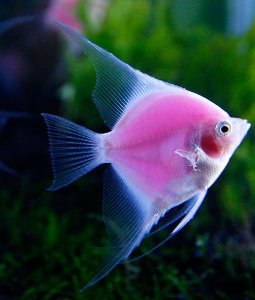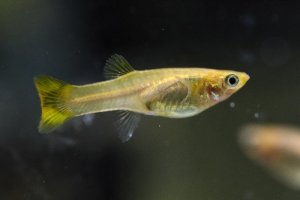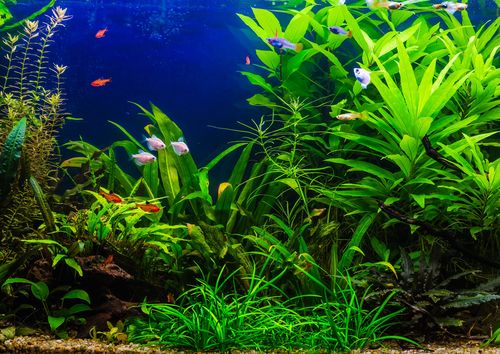
Guppies are among the most popular tropical fish due to their low maintenance, friendly, calm, and pleasant nature. They are perfect community fish that thrive in a plant filled aquarium that provides plenty of hiding spots.
Before visiting your local pet store, knowing which other fish species will naturally get along with your guppies is worth knowing. Some of the attributes to look at for these prospective tank mates are similar dietary requirements, if they are pleasant community fish, physical size, and a tranquil demeanor.
Breeds Ranked As 8 Of The Best Tank Mates For Guppies
1. Molly Fish

A highly recommended species is the molly fish, also known as the common molly. This exotic aquatic pet is highly adaptable and, therefore, would be a good fit with almost all community fish. In addition, its bright colors will spruce up any tank.
The molly fish requires little maintenance and is frequently favorable because it is closely related to the guppy. Guppies and molly fish are from the same subfamily, making these two species ideal companions. Although the male molly may be mildly aggressive, you can quickly curb this behavior by ensuring enough hiding places. Mollies have a lifespan of 3-5 years.
- Size: The standard male size is 3.2 inches or 8 cm, and the female size is 4.8 inches or 12 cm.
- Water Parameters: Tank temperatures should be between 70-80 degrees Fahrenheit.
- Diet: These fish are likely to eat almost anything you drop into the aquarium as they are not fussy eaters. A balanced diet of vegetables and proteins in the form of frozen foods, high-quality flakes, and pellets is recommended.
- Fun Fact: Even though they are so tiny, molly fish have huge appetites.
2. Swordtail
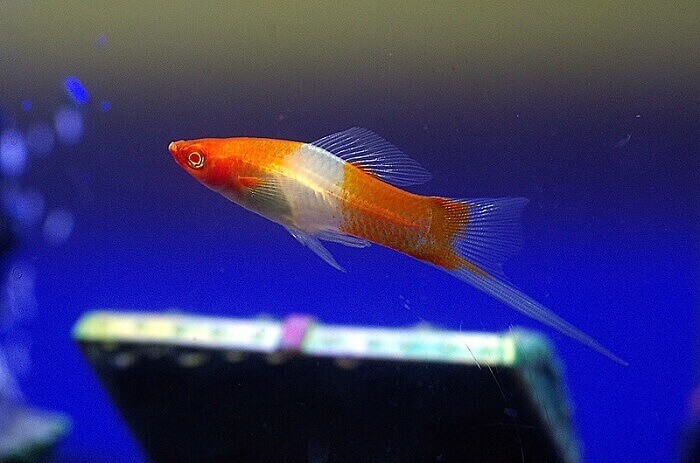
Sometimes mistaken for a platy, the swordtail is considered one of the best tank mates for guppies. Also known for its peaceful temperament and effortless maintenance, this freshwater fish ranks high for beginner aquarists.
What’s notable about this species is its distinctive tail fin that looks like a sword. This is only present in the male, giving rise to its name, swordtail. Its unique appearance will add an eye-catching feature to your aquarium.
- Size: Males can grow up to 5.5 inches or 14 cm, and females grow to 6.3 inches or 16 cm.
- Water Parameters: Temperatures should be between 72-79 degrees Fahrenheit for swordtails to thrive. Other variables like pH, ammonia, and nitrates should also be monitored and kept at safe levels.
- You can house several swordtails in a 10-gallon aquarium; however, to avoid overcrowding, it is best to have a larger tank for bigger groups. A minimum tank capacity of 20 gallons should suffice, but as your numbers grow, so should your tank size.
- Diet: Live or frozen food are both options one can feed swordtails. Worms, algae, plant matter, mosquito larvae, and brine shrimp make up most of the swordtail’s diet.
- Fun Fact: The swordtail belongs to a family of fish that have teeth on both the top and lower jaw.
3. Bristlenose Pleco

Another suitable companion is the bristlenose pleco or bushy nose pleco, as it is known. This relaxed aquatic pet lives amiably with small to medium community fish. Its bristles give it a noticeable appearance that you can add to the diversity of your aquarium.
Like other community fish, they are an easy-to-care-for species that enjoys a busy tank with lots of plants, pieces of wood, or any other tank decor. You may experience occasional territorial disputes with bristlenose plecos. However, if given enough tank space, this may rarely occur.
- Size: The average length of the bristlenose pleco is between 3-5 inches or 7-12 cm
- Water Parameters: Their preferred temperatures are between 60-80 degrees Fahrenheit. A minimum tank capacity of 25 gallons would suit these aquatic pets well.
- Diet: Lettuce, pumpkin, cucumber, peas, and zucchini are some foods that make up their diet. This vegetarian species also enjoy grazing on bogwood, an essential part of their diet. Plecos are also known to be eager algae eaters.
- Fun Fact: The bristlenose pleco’s color patterns provide an excellent disguise that allows them to avoid danger.
4. Rasbora Fish

Overall, rasbora are a quiet and non-aggressive species that gets along with most community fish, making them good tank mates for guppies. In addition, Rasboras will give your aquarium a dazzling look with their bright colors that glisten in the light. Like the guppy, these schooling fish prefer a planted tank. It makes them feel more secure when there are plenty of plants and hiding places.
- Size: The standard length of male fish is 3.2 inches (8 cm), and female fish is 4.8 inches (12 cm)
- Water Parameters: Temperatures should be between 73-82 degrees Fahrenheit with a minimum tank capacity of 30 gallons.
- Diet: The rasbora feed on some of their favorites, such as small insects, brine shrimp, and mosquito larvae. They can also consume flakes and pellets. However, be wary of food sizes due to their tiny size and small mouth opening.
- Fun Fact: There are currently over 100 species of rasboras.
5. Siamese Algae Eater

Siamese algae eaters are another low-maintenance and easy-to-care-for breed. Due to its captivating appearance, the Siamese algae eater won’t go unnoticed in your aquarium. With a bold black stripe on each side of the fish that runs over the entire body length, nose to tail. Siamese algae eaters are fun and social community fish that can get along with any other species in your tank.
- Size: These bottom dwellers can grow up to 6 inches or 15cm in length.
- Water Parameters: Temperatures should be between 72-82 degrees Fahrenheit and a minimum tank size of 20 gallons.
- Diet: Their name already gives away the primary components of their diet. In addition to algae, they should also be fed pellets or flakes high in vegetable content.
- Fun Fact: The Siamese algae eaters are held in high regard in the aquarium owner’s world, as they are the only fish known to consume red algae.
6. Zebra Danios
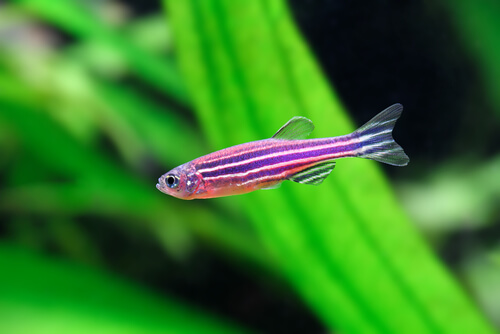
The zebra danios or zebrafish is yet another tank mate to consider. They are active species that thrive in community tanks. Similar size, trouble-free care, and inexpensive maintenance make danios good tank mates for guppies.
Their horizontal stripes give them their glitzy appearance, and their gold colors make them any aquarium’s eye candy. It will be ideal if at least four zebrafish are added to your tank, as they are schooling fish.
- Size: Average size of these breeds is about 2 inches or 5cm
- Water Parameters: These are fish that do well in cooler water, making them suitable for unheated tanks as long as the room is relatively warm. Temperatures must be between 68-75 degrees Fahrenheit. A recommended 10-gallon capacity tank should be used. However, zebra danios love to swim around, and a larger tank would be best.
- Diet: Their diet consists of vegetables, shrimp, worms, flakes, and pellets. Another tiny fish with a small mouth and size, so portions should be small.
- Fun Fact: This fish’s common name comes from the five evenly spaced, pigmented horizontal stripes that run down one side of its body and resemble zebra stripes.
7. Boeseman’s Rainbowfish

These small, peaceful creatures can be pretty skittish and may disturb other fish that are much slower with their rapid movements. However, one of the remarkable qualities of this beautiful species is its coloration, as its scales resemble the rainbow, which is undoubtedly the source of its name. As the rainbowfish become older, their colors become more vibrant.
This fish enjoys socializing with other fish and is a species that is easy to keep and maintain. Therefore, they are also considered good tank mates for guppies. Even though they enjoy being part of a community, they may occasionally seek solitude within the rocks and plants.
- Size: Rainbowfish males grow up to 4 inches or 10cm in length, whereas the females are a bit smaller in size, growing to 3 inches or 8cm.
- Water Parameters: A minimum tank capacity of 30 gallons is required. Temperatures should be between 75-80 degrees Fahrenheit.
- Diet: They should be fed high-quality flake food, along with frozen foods and live foods, which are usually blackworms, bloodworms, and brine shrimp. Rainbowfish should be given modest bits of food at regular intervals.
- Fun Fact: Boeseman’s rainbowfish are well-known for jumping; therefore, if surprised, they may jump out of the tank.
8. Cory Catfish
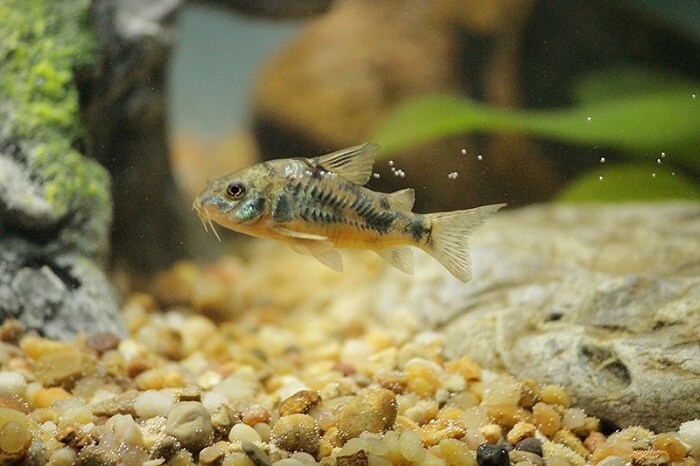
These placid bottom dwellers are friendly and get along with any community fish that won’t eat or attack them. Cory catfish should be grouped into six or more since they feel protected in numbers. Their body is covered with bony plates, serving as protective armor that defends them from harm. In addition, the fish’s flat underbelly makes it ideally suited for living at the lower level of tanks.
They are not primarily algae eaters, so you will need to feed them to ensure they get enough nutrition. If housed with more aggressive eaters, it can be easy for cory catfish to be outcompeted during feeding times, which can cause them stress.
- Size: Their size ranges from 1-4 inches or 3-8 cm
- Water Parameters: A recommended tank capacity of 20 gallons for comfortable living is needed. Ideal temperatures should be between 70-80 degrees Fahrenheit.
- Diet: Cory catfish are bottom feeders and consume anything that will fit in their mouths, including algae, shrimp, fish flakes, pellets, and worms. Both live and frozen food options should also be made available to them.
- Fun fact: Some cory fish, like the julii cory, have the ability to move their eyes in a way that may look like a wink.
The Bottom Line
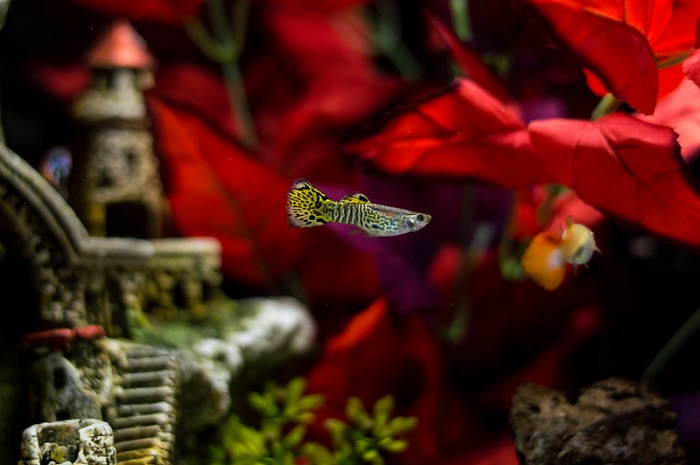
Building a bustling community aquarium with guppies will be much easier when you know what to look for. Always do research when considering adding another species to your tank. In addition, keep the tank size in mind to ensure a well-balanced aquarium.
Monitor the different species’ behavior and interaction with one another. Take time recording this data to assist you in selecting the best tank mates for guppies in the future. It’s also essential to remember that schooling fish are happiest when grouped with five or more of the same species. Remember, ‘Happy fish, healthy fish.’


